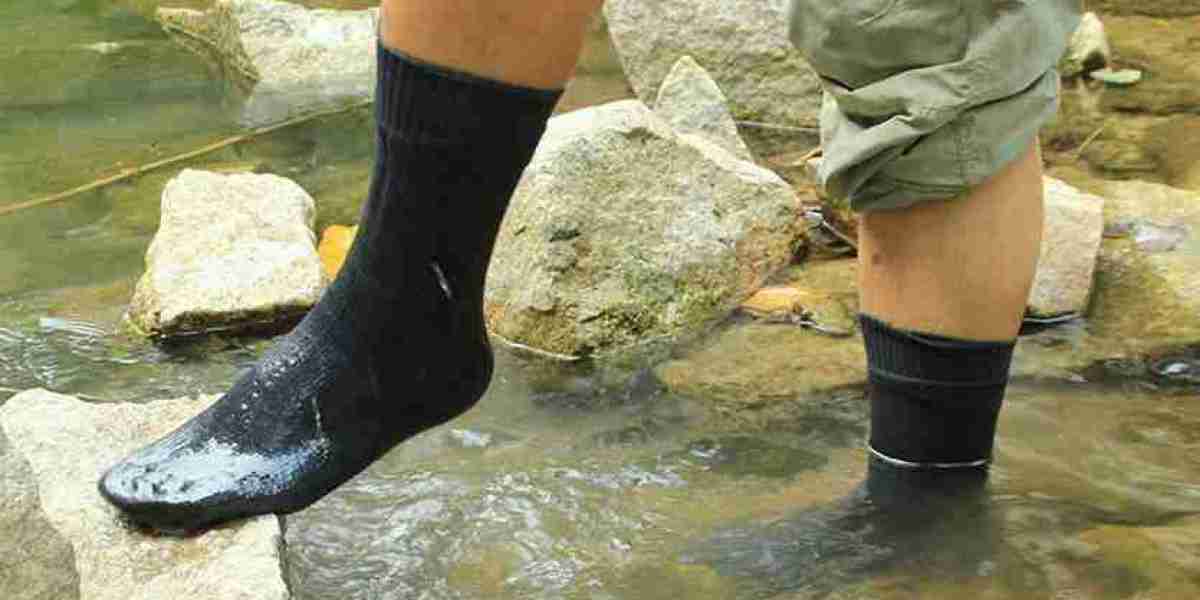Introduction
The Waterproof Socks Market has seen significant growth, driven by consumer demand for performance apparel that ensures dryness, comfort, and durability across a wide range of activities. Behind the final product lies a complex value chain that includes raw material procurement, product design, manufacturing, distribution, and retail. Understanding this value chain is essential for brands aiming to enhance profitability, optimize production, and expand retail presence. This article offers a detailed breakdown of the waterproof socks value chain and highlights key retail expansion trends shaping the industry.
Understanding the Value Chain in the Waterproof Socks Market
A well-optimized value chain ensures not only cost-efficiency but also product consistency and speed to market. The value chain for waterproof socks typically includes the following stages:
1. Raw Material Sourcing
Waterproof socks are made from multiple layers involving technical materials:
Outer Layer: Often made of nylon, polyester, or elastane for durability and flexibility.
Middle Layer: Comprises a waterproof and breathable membrane like polyurethane, Porelle®, or eVent®.
Inner Layer: Materials such as Merino wool, bamboo charcoal, or Coolmax® for comfort and moisture-wicking.
Sourcing eco-friendly and performance-grade raw materials is a growing focus as sustainability becomes a competitive advantage.
2. Product Design and Development
This involves R&D into:
Waterproofing techniques (seamless bonding, membrane integration)
Anti-odor and anti-bacterial technologies
Ergonomic fits and sizes
User-specific variations (cycling, hiking, winter sports)
The design phase integrates market trends, technological innovations, and customer feedback.
3. Manufacturing
The production process includes:
Layer bonding and lamination
Seamless stitching or sealing for leak prevention
Quality control tests (hydrostatic pressure, breathability, elasticity)
Most manufacturing is outsourced to specialized facilities in countries like China, Vietnam, and India due to cost-efficiency and skilled labor.
4. Distribution and Logistics
After production, waterproof socks are distributed through:
Wholesalers and distributors
Third-party logistics partners
Direct-to-consumer (D2C) channels
E-commerce platforms
Efficient inventory management and fulfillment are key to meeting seasonal demand spikes and ensuring customer satisfaction.
5. Retail and Customer Engagement
The final stage is retail, where brand storytelling, packaging, and customer experience drive sales.
In-store display optimization
E-commerce branding
After-sale services (return policies, size exchanges)
Loyalty programs and reviews
Retail Expansion Trends in the Waterproof Socks Market
With demand rising globally, especially in urban and outdoor-active regions, retail strategies have evolved significantly.
1. Omnichannel Retailing
Brands are embracing a hybrid approach—offering seamless experiences across physical stores, online marketplaces, and brand websites.
Example: A customer tries socks in-store but orders online for delivery.
Features: Click-and-collect, mobile app integration, loyalty rewards across channels.
2. D2C Brand Growth
Many new waterproof sock brands are bypassing traditional retail and selling directly to customers online.
Benefits: Better profit margins, customer data access, and faster feedback loops.
D2C Brands Focus On: Unique product features, fast delivery, and influencer-led marketing.
3. Retail Partnerships and Pop-Up Stores
To expand reach and test new markets, brands are partnering with:
Outdoor gear chains (e.g., Decathlon, REI, Cabela’s)
Apparel retailers to sell waterproof socks as accessories
Pop-up stores at sports expos and adventure festivals
4. Regional Retail Expansion
Retailers are focusing on regions with high outdoor activity and wet or cold climates:
North America (Pacific Northwest, Northeast U.S., Canada)
Europe (UK, Scandinavia, Germany)
Asia-Pacific (Japan, South Korea, parts of China and India)
Localized marketing campaigns and climate-specific inventory help brands capture regional interest.
5. Sustainability-Driven Retail
Eco-conscious customers are gravitating toward retailers that emphasize:
Sustainable packaging
Transparent supply chains
Certifications (e.g., OEKO-TEX®, Global Recycled Standard)
Retailers now dedicate shelf space and landing pages to “eco gear” where waterproof socks often feature.
Challenges in the Value Chain and Retail Expansion
Despite growing opportunities, brands face several hurdles:
Rising Raw Material Costs: Especially for advanced waterproof and eco-friendly materials
Supply Chain Disruptions: Political instability or shipping delays can affect inventory
Counterfeit Products Online: Diminish consumer trust and erode premium brand value
Complex Inventory Management: Seasonal demand, sizing variations, and regional preferences complicate stock control
Opportunities for Optimization
Vertical Integration: Some brands are investing in their own manufacturing or materials sourcing to control costs and quality.
Collaborative Logistics: Shared distribution centers among performance brands can lower shipping costs and reduce carbon footprints.
Data-Driven Retail Expansion: Using AI to predict which regions or demographics to target next.
Modular Product Design: Socks with interchangeable liners or features for versatile use cases.
Conclusion
The Waterproof Socks Market is backed by a dynamic and multi-layered value chain that requires continuous innovation, flexibility, and consumer insight. As retail landscapes shift toward digital, data-centric, and sustainability-focused models, brands that streamline their value chain and align with modern retail trends will be best positioned for long-term success.




